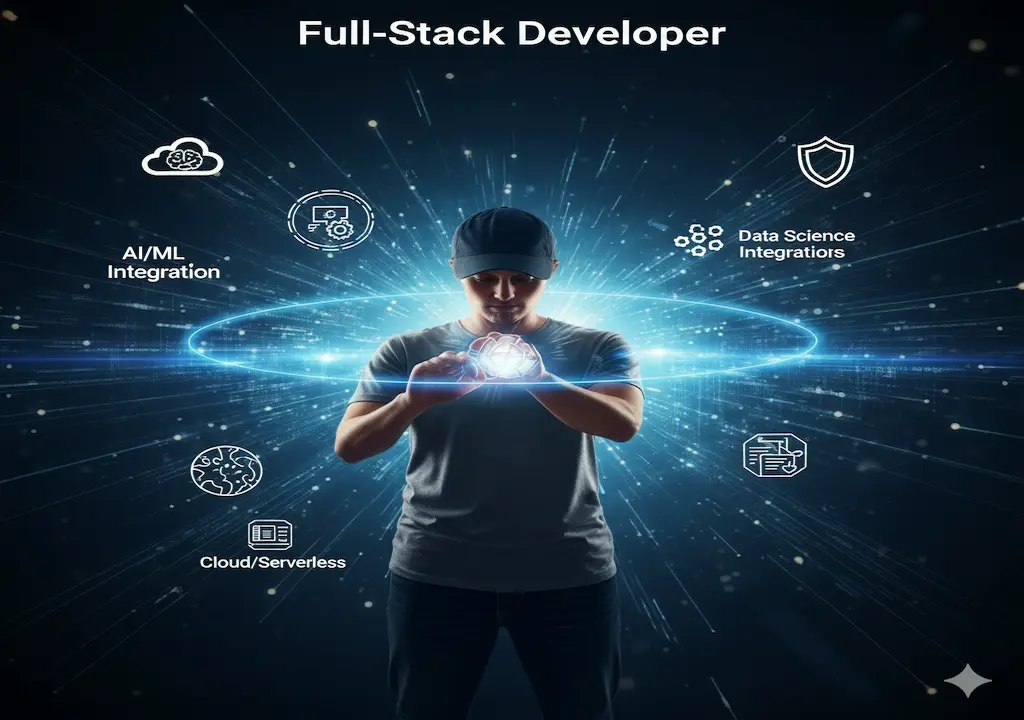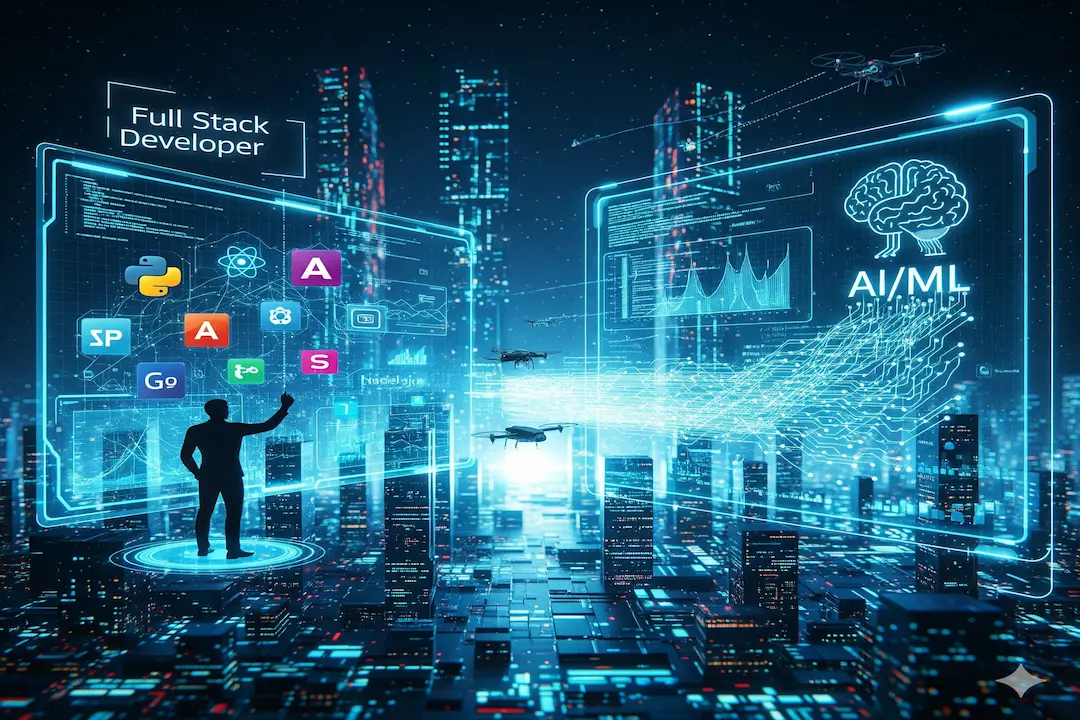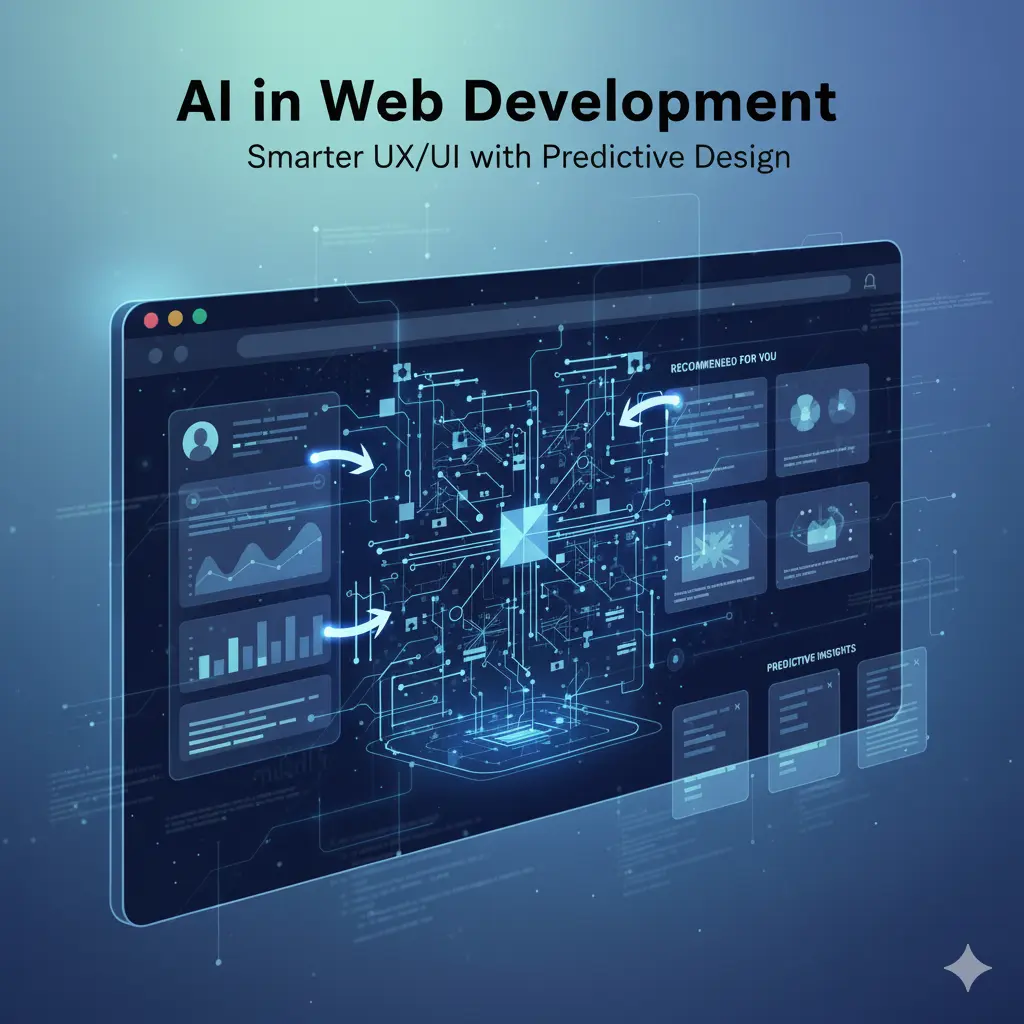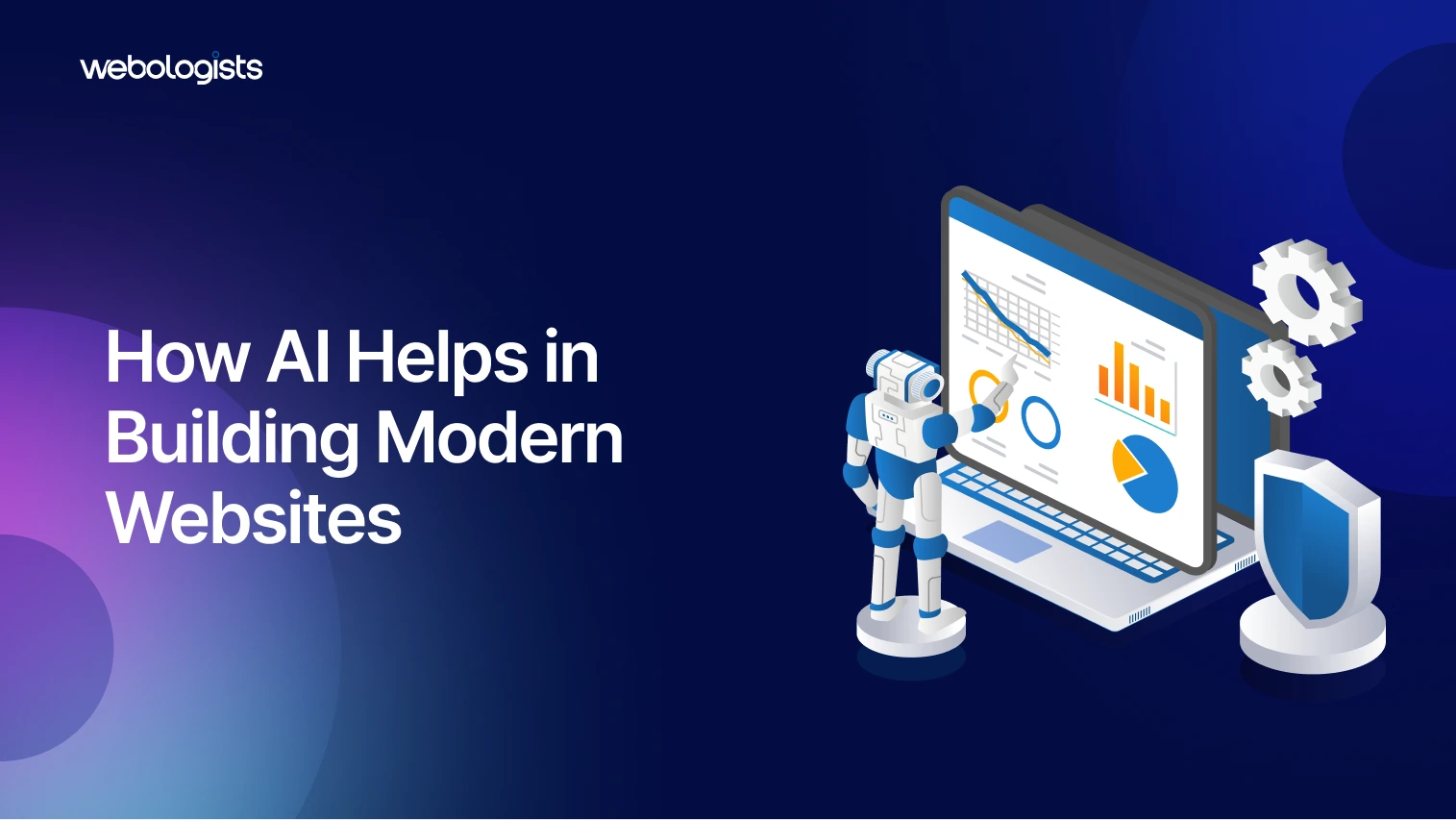
The digital world is always changing, but seldom has it seen a shift as deep and fast as the one now driven by Artificial Intelligence (AI) and Machine Learning (ML). For small business owners in tech, marketing professionals tackling digital strategies, and enterprise IT leaders, grasping these changes isn’t just a perk, it’s vital for strategic planning and staying competitive. We’re at the edge of a new era where AI and ML are not just trendy terms, but foundational technologies actively reshaping the very core of web development.
This evolution brings both exciting chances and significant hurdles, especially for the full stack developer, a role traditionally defined by its breadth across front-end and back-end areas. As AI and ML become central to every phase of development, from initial ideas to launch and ongoing support, the demands on these essential professionals are changing at a rapid pace. By 2025, the full stack developer’s tools and outlook will be dramatically different, requiring a mix of traditional coding skill and fresh AI/ML knowledge. This article will explore how these technologies are revolutionizing web development, examine the shifting expectations for full stack developers, highlight key trends to watch by 2025, and offer practical advice for staying ahead in this fast-moving field.
Table of Contents
The Revolution of Web Development Through AI and ML
Integrating AI and ML into web development isn’t just an upgrade; it’s a complete change in approach. These technologies are fundamentally altering how applications are envisioned, built, and interact with users, paving the way for smarter, more efficient, and deeply personalized digital experiences. For IT decision-makers, this means better operational efficiency and quicker market entry. For marketing professionals, it offers deeper user insights and intensely personalized campaigns.
Understanding AI and ML in Web Development
At its heart, Artificial Intelligence (AI) refers to systems or machines that imitate human intelligence to perform tasks and can continually improve themselves based on the information they gather. Machine Learning (ML), a part of AI, focuses on creating algorithms that let computers learn from data without explicit programming. When used in web development, this translates to:
- Intelligent Automation: Automating common, repetitive coding tasks, testing, and even debugging processes.
- Enhanced User Experience: Crafting highly personalized content, recommendations, and responsive interfaces.
- Data-Driven Insights: Analyzing vast amounts of user data to boost performance, predict trends, and guide design choices.
The adoption of AI and ML in software development is soaring. Recent industry reports indicate that over 60% of development teams are already experimenting with or actively integrating AI tools into their workflows, a number projected to rise dramatically to nearly 90% by 2025. This isn’t just for large companies; small to medium-sized businesses are increasingly using readily available AI tools to level the playing field, making “AI tools for productivity” a key priority.
Automation of Coding Processes
One of the most clear impacts of AI and ML in web development is the automation of coding processes. The days when developers carefully wrote every line of code from scratch for common functions are largely over. AI-powered tools are now capable of generating boilerplate code, suggesting code snippets, and even finding and fixing errors in real-time.
Consider tools like GitHub Copilot, a prime example of an AI pair programmer. It analyzes existing code and comments to suggest entire lines or functions, significantly speeding up development cycles. This automation extends to:
- Front-end Development: AI can create responsive UI components, optimize image assets, and even suggest design patterns based on user preferences and data.
- Back-end Development: Automated API generation, database schema design, and serverless function deployment are becoming more and more common.
- Testing and Quality Assurance: ML algorithms can foresee potential bugs, generate test cases, and automate complex testing scenarios, ensuring higher code quality and faster releases.
This shift means developers can dedicate more time to complex problem-solving, creating innovative features, and strategic architectural design, rather than getting stuck in repetitive coding. For small business owners, this translates into faster project delivery, reduced development costs, and the ability to innovate more rapidly.
Evolving Expectations for Full Stack Developers

The traditional definition of a full stack developer is expanding and being redefined. While expertise in both front-end (e.g., HTML, CSS, JavaScript, React, Angular, Vue.js) and back-end (e.g., Node.js, Python, Ruby, Java, database management) technologies remains vital, the rise of AI and ML adds several new layers of complexity and opportunity.
The Growing Demand for Versatile Skill Sets
The market demand for full stack developers continues to increase, but the nature of that demand is shifting. Job postings increasingly highlight not just technical skill, but also an understanding of data science principles, machine learning concepts, and the ability to integrate AI models into web applications. Statistics show that job descriptions mentioning “AI integration,” “machine learning frameworks,” or “data engineering” for full stack roles have jumped by over 40% in just the last two years.
This isn’t about becoming a data scientist overnight, but about having a foundational understanding that allows for smooth collaboration and effective implementation of AI-powered features. Developers who can bridge the gap between traditional web development and emerging AI/ML paradigms will be the most sought after.
Beyond Traditional Development Roles
The days of full stack developers focusing solely on CRUD (Create, Read, Update, Delete) operations are behind us. The modern full stack developer is becoming more of an architect of intelligent systems, tasked with:
- Integrating AI Models: Deploying pre-trained ML models into web applications for tasks like natural language processing, image recognition, or predictive analytics.
- Data Pipeline Management: Understanding how to gather, process, and store data effectively to feed AI models and extract useful insights.
- Ethical AI Considerations: Being aware of biases in data and models, and working to build responsible and fair AI-powered applications.
- DevOps with MLOps: Extending traditional DevOps practices to include the lifecycle management of machine learning models (MLOps), ensuring smooth deployment and continuous improvement of AI features.
Essential technologies for the full stack developer by 2025 will go beyond traditional frameworks. While mastery of popular front-end libraries like React or Vue.js and back-end runtimes like Node.js or Python is still crucial, proficiency in machine learning frameworks such as TensorFlow.js, PyTorch, or Scikit-learn, alongside cloud platforms (AWS, Azure, GCP) with their AI services, will be distinguishing factors.
Table 1: Evolution of Full Stack Developer Skill Sets
| Traditional Full Stack Skills (Pre-2020) | Emerging/Essential Full Stack Skills (By 2025) |
|---|---|
| HTML, CSS, JavaScript | Advanced Front-end Frameworks (React, Vue, Angular) |
| Server-side languages (Node.js, Python) | Cloud Platforms (AWS, Azure, GCP) |
| Relational/NoSQL Databases | Machine Learning Frameworks (TensorFlow.js, PyTorch) |
| RESTful APIs | GraphQL, Serverless Architectures |
| Basic Version Control (Git) | Advanced DevOps/MLOps Practices |
| Responsive Design | Adaptive UI/UX Design, Personalization Engines |
| Basic Testing | AI-powered Testing & Quality Assurance |
| Web Security Fundamentals | Data Privacy, Ethical AI, Bias Mitigation |
Future Trends in Web Development by 2025
The path of AI and ML integration points to several groundbreaking trends that will define web development by 2025. These trends offer strategic chances for IT leaders and marketing professionals to boost user engagement, streamline operations, and gain a competitive edge.
Adaptive User Interfaces
Imagine a website or application that intuitively understands your preferences, adapts its layout and content based on your current situation, and even anticipates your next move. This is the promise of adaptive user interfaces (Adaptive UI), heavily driven by AI and ML. Instead of static designs, UIs will dynamically change based on:
- User Behavior: Tracking interaction patterns, clicks, and navigation paths.
- Contextual Data: Location, time of day, device type, network speed.
- Personalized Preferences: Learning individual user choices over time.
Examples of current adaptive interfaces include personalized content feeds on social media platforms, e-commerce sites recommending products based on browsing history, and intelligent chatbots that learn from user interactions. By 2025, this will expand to entire website layouts, real-time content generation, and truly smart assistants built into applications, offering highly personalized and engaging user experiences. For marketing professionals, this means an unprecedented ability to deliver ultra-relevant content at precisely the right moment.
Automation in Development Processes
While we’ve discussed coding automation, the future holds potential for even more profound automation across the entire development lifecycle, leading to what some call “autonomous development.” This isn’t about replacing developers entirely, but empowering them to work at a higher, more strategic level.
- AI-driven Code Generation: Moving beyond snippets to generating entire modules or even small applications from high-level requirements.
- Predictive Maintenance: AI systems monitoring deployed applications, foreseeing potential failures before they happen, and suggesting fixes or even carrying them out autonomously.
- Automated Deployment and Scaling: ML models optimizing resource allocation and scaling decisions for cloud infrastructure in real-time.
The implications for developer careers are significant. While repetitive coding tasks may be fully automated, the demand for developers with strong problem-solving skills, architectural vision, and an understanding of AI ethics will skyrocket. The focus will shift from how to code to what to build and how to leverage AI to build it smarter.
Table 2: Key AI/ML Trends and Their Impact on Web Development by 2025
| Trend | Description | Impact on Development & Business |
|---|---|---|
| Generative AI for Code | AI generating functional code, documentation, and tests from prompts. | Faster development cycles, reduced manual effort, higher code consistency. |
| AI-Powered UX/UI Design | Tools that suggest design elements, optimize layouts, and personalize experiences. | Enhanced user engagement, improved conversion rates, data-driven design decisions. |
| Intelligent Testing & Debugging | ML algorithms predicting bugs, generating test cases, and automating fixes. | Higher software quality, faster releases, significant cost savings in QA. |
| Low-Code/No-Code Platforms (AI-Enhanced) | Platforms with AI assistance to build complex applications with minimal coding. | Democratization of development, rapid prototyping, increased agility for small businesses. |
| Edge AI for Web | Running AI models directly in the browser for faster, more private interactions. | Improved performance, reduced server load, enhanced data privacy, real-time personalization. |
| AI-Driven Personalization | Hyper-tailored content, recommendations, and adaptive experiences. | Unprecedented user satisfaction, stronger brand loyalty, superior marketing effectiveness. |
Implications for Developers
The transformative power of AI and ML is not a threat to developers but an invitation to grow. For full stack developers, embracing these changes isn’t optional; it’s vital for career longevity and advancement. Small business owners looking to hire or train their teams, and IT leaders shaping their tech strategies, must recognize the critical need for continuous learning.
Keeping Skills Updated
The speed of technological change demands a commitment to continuous learning. Developers who thrive in this new landscape will be those who actively seek out new knowledge and adapt their skill sets. Here are actionable tips for continuous learning and skill enhancement:
- Master the Fundamentals of ML: Understand core concepts like supervised vs. unsupervised learning, neural networks, and common algorithms. You don’t need to be a data scientist, but grasp the principles.
- Learn AI-Specific Frameworks/Libraries: Explore libraries such as TensorFlow.js for client-side ML, or integrate Python-based ML services into your back-end.
- Embrace Cloud AI Services: Become proficient with services offered by AWS (SageMaker, Comprehend), Azure (Azure ML, Cognitive Services), and Google Cloud (AI Platform, Vision AI), which simplify much of the complexity of ML.
- Focus on Data Literacy: Understand data collection, cleaning, ethical use, and how to prepare data for ML models.
- Practice with AI Tools: Experiment with tools like GitHub Copilot, Replika, or AI design assistants to understand their capabilities and limitations.
- Develop Ethical AI Awareness: Learn about algorithmic bias, fairness, transparency, and data privacy regulations. Building responsible AI is paramount.
Resources for developers are plentiful, making it easier than ever to stay current:
- Online Courses: Platforms like Coursera, Udacity, edX, and Pluralsight offer specialized courses in AI/ML for developers, often taught by leading industry experts.
- Webinars and Workshops: Many tech companies and developer communities host free or paid sessions on emerging AI/ML topics.
- Developer Documentation: Official documentation for frameworks like TensorFlow.js or cloud AI services provides invaluable, up-to-date information.
- Open Source Projects: Contribute to or learn from open-source AI/ML projects on GitHub.
- Community Forums: Engage with developer communities (e.g., Stack Overflow, Reddit’s r/MachineLearning, r/webdev) to share knowledge and troubleshoot.
- Blogs and Tech Publications: Follow thought leaders and reputable tech blogs that focus on AI, ML, and web development trends.
By proactively engaging with these resources and integrating new knowledge into their daily work, full stack developers can not only adapt but lead in the AI-driven web development era.
Conclusion
The future of web development is undeniably linked with Artificial Intelligence and Machine Learning. By 2025, these technologies will not just be extra tools but fundamental forces reshaping how we build, interact with, and experience the digital world. For small business owners, embracing AI/ML offers unmatched opportunities for innovation and efficiency. For marketing professionals, it promises unprecedented personalization and insight. And for enterprise IT leaders, it unlocks new levels of operational excellence and strategic advantage.
For the full stack developer, this represents an exciting, though demanding, evolution. The role will shift from primarily code implementation to strategic problem-solving, AI integration, and the creation of intelligent, adaptive systems. The importance of continuous learning cannot be overstated. Those who commit to expanding their skill sets to include AI and ML knowledge will not only stay relevant but will emerge as the architects of tomorrow’s web. The journey might seem daunting, but the landscape of opportunity is vast and incredibly rewarding for those willing to adapt and innovate.
Ready to turn your vision into a market-ready product? Let Webologists be your tech partner from strategy through launch , book your free 30-minute discovery call today and let’s start building your future together.
FAQs
-
What is Product-Market Fit (PMF) and why is it crucial for AI startups?
PMF is the ideal state where your product effectively satisfies a significant market demand, creating a foundation for sustained growth. For AI startups, achieving PMF isn’t optional; it’s vital for survival, ensuring your innovative solution truly connects with user needs and avoids high churn.
-
How does AI itself accelerate the process of achieving Product-Market Fit?
AI significantly speeds up PMF by enabling rapid product iteration and pinpointing user needs with data-backed insights. It leverages automated data analysis, predictive analytics for feature prioritization, and real-time A/B testing to quickly adapt and optimize AI products for the market.
-
What are the dangers for founders who misinterpret early positive traction as true PMF?
Misinterpreting early traction from niche users or enthusiasts can lead to overconfidence and a false sense of PMF. This optimism bias risks wasting resources, delaying crucial strategic shifts, and ultimately imperiling the startup’s future due to a lack of genuine, scalable market demand.
-
How should AI founders effectively measure Product-Market Fit for their unique products?
AI founders should track metrics beyond basic engagement, focusing on AI feature adoption rate, the accuracy and relevance of AI outputs, and the time-to-value users gain from AI. It’s crucial to also assess user disappointment if AI features were removed and the efficiency gains provided by the AI system.
-
Should AI founders view Product-Market Fit as a fixed destination or an evolving process?
PMF is a continuous spectrum, not a one-time achievement. AI founders must constantly evaluate and adapt their products due to dynamic markets, evolving user expectations, and rapid technological advancements, ensuring their AI solutions remain relevant, valuable, and competitive over time.





